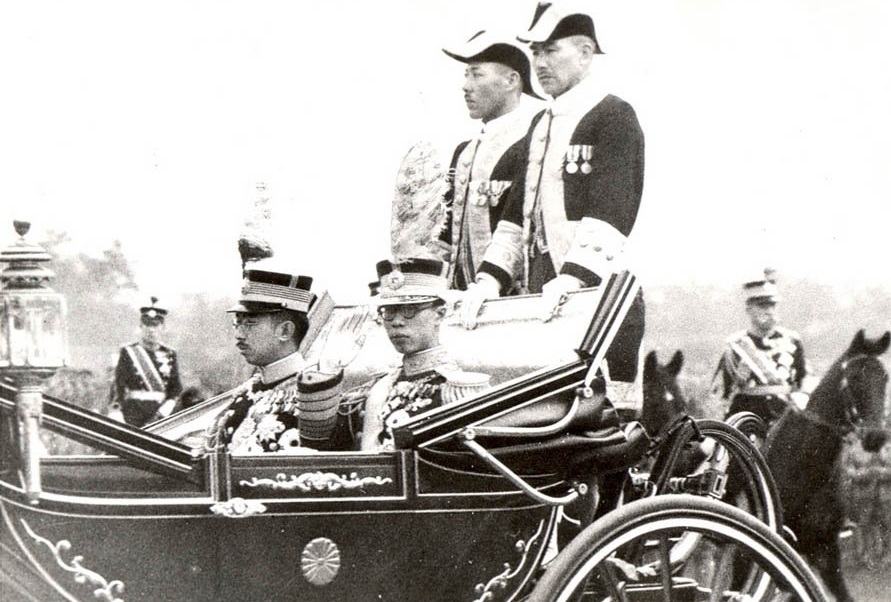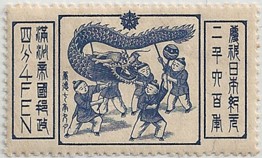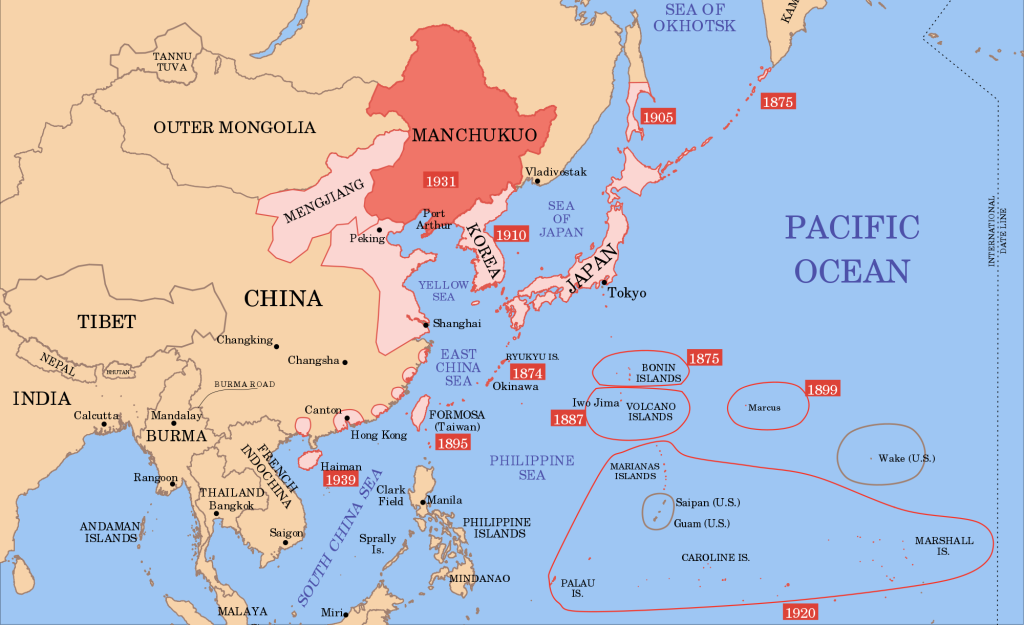ALBUM – view my Manchukuo album
Fast Facts
Region: China Area
Group: Japanese Puppet States and Occupations
Classification: Puppet state
Prior Regime: Republic of China
Key Dates:
1931 – Japan invades Manchuria
1932, Mar 1 – Manchukuo state formed by the Japanese
1934, Mar 1 – The Empire of Manchukuo was proclaimed with the Coronation of Emperor Pu-Yi
1935, Apr – Emperor Puyi visits Japan for discussions with the Emperor of Japan
1937, Jul 7 – The second Sino-Japanese war begins
1941, Dec 7 – World War 2 in the Pacific starts with the bombing of Pearl Harbor
1945, Aug 8 – Soviet Forces Invaded Manchukuo, ending the Empire.
Following Regime: Soviet Occupation of Manchuria
Scott Catalogue: (Manchukuo) 1-164, C1-C5
Pick Catalogue: (Manchukuo) J120-J146
History

In the late 1800’s the Japanese began an aggressive expansion onto the Asian mainland, primarily to create a buffer between Japan and the expansion of the Russian empire into the Far East. In 1894-95 Japan invaded Korea causing the first Sino-Japanese War. Seeing that the world was unwilling to support China, they extracted harsh concessions to end the war. In addition to making Korea “independent”, Japan demanded Formosa (Taiwan) and the the strategic Kwantung Peninsula on the southern coast of Manchuria. In Korea, the Japanese disposed the King and installed a Japanese puppet government. Eventually Japan annexed Korea to be a part of Japan in 1910.
Continuing their expansion, Japan invaded Manchuria in 1931 and on March 9th, transitioned from a Military Government to establish the Manchu State (Manchukuo). To attempt to set up legitimacy of the government, they invited the last Emperor of China, Aisin Gioro Puyi, who lived in the Japanese concession of Tianjin to serve as Chief Executive of Manchukuo. Over time, only 23 of the 80 official nations in existence recognized ever Manchukuo. Including Germany, Italy, Vichy France, the Soviet Union, Spain, El Salvador and the Dominican Republic.
Two years later, the state was “elevated” to the Empire of Manchkuo, and Chief Executive Puyi was crowned Emperor Kangde. While the name of the country changed, it remained as a puppet government under tight control from Japan. Despite Puyi’s interest in re-instating Chinese traditions and values to the “empire”, he had little real power. The Emperor was assigned Japanese senior staff who kept a tight rein on the Puyi, slowing moving the country to become more Japanese in law, tradition and even religion.
During it’s existence, Japan greatly expanded Manchukuo’s (and all of Manchuria’s) industry capacity and transportation system. The primary purpose was to develop the country as a base for further expansions into China. However, Japan also attempted to build a ideal nation in Asia. This included modernizing the capital and overall infrastructure, as well as increasing cooperation between private and government industries.
All of this was cut short by War. More than 4 years before the start of WW2 in the Pacific, war broke out between Japan and China. The conflict had been brewing for years with the imperial ambitions of Japan and the ongoing civil wars in China, full scale war finally erupted in July of 1937 and Japan launched an invasion of China. And in this war, Manchukuo was the jumping off point for the invasion. Japan took control of various strategic areas in China, but eventually a stalemate was reached in 1939, with Japan in control of key areas including Nanjing, Shanghai and many important coastal regions. However, Japan had now built its war machine to a point that additional raw materials and industrial capacity was needed, which allowed them to initiate the War in the Pacific.
When World War 2 broke out, Manchukuo continued to be a ally of of Japan as national conscription laws were enacted, and military support (men and materials) continued to be a primary industry. After the war in Europe ended, according to the Yalta Conference, the Soviets agreed to enter the war in the Pacific. On Aug, 9th, 1945, the Soviet Union declared war on Japan and invaded Manchukuo and other parts of Manchuria. This invasion was well timed with the bombings in Hiroshima on Aug 6th and Nagasaki on Aug 9th. The Soviets overwhelmed the troops in Manchukuo and little resistance was encountered. With the surrender of Japan on Aug 15th, Puyi stepped down as “Emperor”, and was captured on Aug 16th, as he was attempting to flee to Tokyo to surrender to the Americans. The Soviets withdrew their troops in May of 1946, after thoroughly plundering the region.
Stamps
 ALBUM
ALBUM
Over 13 year history of Manchukuo, a variety of stamps were issued. While Manchukuo was not recognized by most countries, and never joined the Universal Postal Union, most countries delivered their mail.
Definitive stamps come in two periods. From 1932-35, the lower denominations featured the Pagoda at Liaoyang, and the higher denominations a portrait of Puyi when he was Chief Executive. The initial stamps were inscribed at the top “Manchu State Postal Administration” (5 Chinese characters) and after the formation of the empire, the inscription was changed to “Manchu Empire Postal Administration (6 Chinese characters). Beginning in 1936, definitive stamps were re-designed with various scenes of Manchukuo. In 1944, additional stamps were printed but the wartime prints were rather crude.
Manchukuo issued some very interesting and attractive commemorative stamps. When examining the commemorative issues, one could easily follow many of the important events of Manchukuo’s history. These sets include:
– 1st Anniversary of the establishment of Manchukuo – Mar 1, 1933
– Enthronement of Emperor Kang-de – Mar 1, 1934
– Visit of Emperor to Tokyo – Apr 2, 1935
– Postal convention with Japan – Jan 26, 1936
– 5th Anniversary of the establishment of Manchukuo – Mar 1, 1937
– Completion of the national capital, Hsinking – Sept 16, 1937
– Abolition of Japanese extraterritorial rights in Manchukuo – Dec 1, 1937
– New Year’s Greeting – Dec 13, 1937
– Founding of the Red Cross Society in Manchukuo – Oct 15, 1938
– Completion of 10,000 km of railroad in Manchuria – Oct 21, 1939
– 2nd visit of Emperor Puyi to Tokyo – 1940
– Promotion of Oct 1st 1940 National Census – Sept 10, 1940
– 2600th Anniversary of the birth of Japanese Empire – Sep 18, 1940
– Promotion of Jun 1, 1941 conscription law – May 25, 1941
– Commemorating the fall of Singapore – Feb 16, 1942
– 10th anniversary of the establishment of Manchukuo – Mar 1, 1942
– 10th anniversary of the Japanese “formal” recognition of Manchukuo – Sep 15, 1942
– 1st anniversary of the “Greater East War” (WW2) – Dec 8, 1942
– Proclamation of the Compulsory Labor Service Law – May 1, 1943
– 5th anniversary of the founding of the Manchukuo Red Cross – Oct 1, 1943
– 2nd anniversary of the “Greater East War” – Dec 8, 1943
– Friendship with Japan – Oct, 1944
– 10th anniversary of the Emperor’s “rescript” – May 2, 1945
Additionally, in 1936-37, Manchukuo issued a set of four Air Post stamps, similar in design and size as the definitive stamps.
Banknotes
The official currency in Manchukuo was the Manchukuo yuan. 10 li = 1 fen, 10 fen = 1 chiao, 10 chiao = 1 yuan. Originally the yuan was tied to the silver standard, but in 1935 it changed to be pegged to the Japanese yen. During its 13 year existence, Manchukuo released three series of banknotes, 1932, 1935-38 and 1941-45. The Series included the following denominations:
– 1932 – 50 fen, 1, 5, 10, 100 Yuan
– 1935-38 – 50 fen, 1, 5, 10, 100 Yuan
– 1941-34 – 10, 50, 50 fen, 1, 5, 10, 100, 100, 1.000 Yuan
Links
Manchukuo Propaganda Video (1937) – very interesting
Manchukuo History from Wikipedia
Manchukuo Stamps (this is an excellent sight)
The Fascinating stamps of Manchukuo by Michael Rogers
Banknotes of Manchukuo at ATS Notes
Manchukuo Yuan at Wikipedia






Ready to help any time you may need it.
Dan
Well, Harbin was a center for currency dealings. All currencies were excepted there – from Russian Rubbles, to US Dollars, British Pounds, French Franks, Portuguese, Swedish, Hungarian, and any other currency one would imagine using.
I can imagine, especially as Harbin was one of the later Treaty Ports. I imagine that the city has seen it’s share of foreigners over the years, especially military types. Russian and Japanese armies have occupied the city, and it is my understanding that it was a major center for defeated White Army refugees to flee.
I see that you are an expert in the area, I am always open to correction and expert input to my humble site.
Regards
Michael
Where does the term Gobi for money comes from?
Hi Dan
Welcome to DCStamps. Humm, I am not sure I know the word gobi (other than the desert in Mongolia). Did I use it somewhere? If so, it was probably a typo.
Regards
Michael
The term Gobi is for the currency that was use by the Chinese during the occupation of Manchuria and the Manchukuo, Japanese Puppet State (1932 – 1945).
Dan
Thanks Dan
That is interesting, I was unaware of that. I assume the etymology of the word was still the desert, as both bordered the Gobi. I can also see a another meaning — barren land, barren currency.
Michael
Nice post on this fascinating subject. Amazing how Japan in some 75 years developed from a backwater country to a super power. And in the end overreached I guess…
Gerben
Thanks Gerben, As usual, there is a huge backstory to why Japan rose to power so quickly, A lot of it was modeled on how the countries of the west played the Great Game during the last half of the 19th century.
Michael
Fascinating period of history! I watched the propaganda video, and then the life of puyi.
A stamp interest can lead down interesting byways and alleys. 😉
Thanks Jim. The whole history of the Japanese Imperial Expansion is fascinating, although quite brutal and bloody. Michael